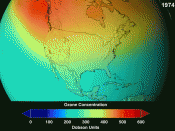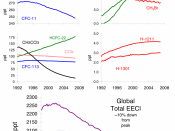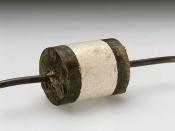1.CFCs and substitutes and the ozone hole.
The environmental effects of CFCs and their substitutes
a.CFCs - highly stable molecules, lifetime in the atmosphere of between 50 and 100 years; contain 2 or 3 chlorine atoms.
b.CFCs substitutes ( transitional compounds)
i.HCFCs - one or more of the chlorine atoms has been replaced by hydrogen atoms, lifetime in the atmosphere about 20 years, have a tenth or twentieth of the potential damage of the CFCs.
ii.HFCs - all the chlorine is replaced by hydrogen - not damaging to ozone - lifetime in the atmosphere about 20 years.
c.All of these three families of compounds are also very potent greenhouse gases.
d.Some hydrocarbons - propane and isobutene - are now increasingly used as a "greener" alternative to both the CFCs and their transitional replacement.
The hole in the ozone layer
a. The stratosphere - 10 to 50 km above the Earth's surface - contains ozone which absorbs some of the more dangerous forms of solar radiation [UV radiation and X-Rays].
b. The thickness of the ozone layer can fluctuate by several percentages every day.
c.The ozone layer is affected by halogenated substances, such as chlorine (Cl), fluorine (Fl) and bromine (Br) compounds.
d.Production and use of these substances is being reduced substantially under the Montreal Protocol.
e.Deterioration of the ozone layer is typically a global problem.
2.Air pollution and what are the main pollutions
In burning process the following is involved:
çResources are consumed.
çUseful services are provided.
çWaste gases are produced.
Here are the main air pollutants that arise from fossil fuel burning, along with some of their key effects on human health.
oSulphur dioxide (SO2) - causes acid rain - source; power stations and other large...


